Financial Stability Review – October 2017 1. The Global Financial Environment
Global economic conditions have strengthened further since the previous Financial Stability Review. However, historically low interest rates are contributing to financial risk-taking, and a range of asset prices appear increasingly elevated. High asset values and low financial market volatility suggest that some investors may be underestimating the downside risks they face, which may increase the likelihood of a disruptive correction. Favourable borrowing conditions have encouraged corporates and households in some jurisdictions to extend already historically high levels of debt. This has raised concerns about borrowers' resilience to negative shocks – such as a sudden rise in interest rates or fall in earnings – and the potential flow-on effects to banks and financial systems more broadly.
While risks have been building in asset markets, to which banks are somewhat exposed, the resilience of banking systems has otherwise been improving. Profit expectations are being buoyed by strengthening economic conditions, and banks' regulatory capital ratios have generally increased further. In Europe, some uncertainty has been removed by regulatory actions to deal with several weaker banks in Italy and Spain, although banks' profits in these jurisdictions are still low and overall the European financial system remains vulnerable to negative shocks.
Risks remain elevated in China. Debt levels are high, largely driven by corporate borrowing, with a significant share of debt funded through less regulated ‘shadow banking’ channels. This has led to considerable credit, liquidity and contagion risks in the Chinese financial system. However, recent regulatory measures have the potential to lower financial stability risks over the longer term. Risks in other emerging markets have receded somewhat. Nevertheless, some emerging economies remain vulnerable to a shift in sentiment and capital flight, which could expose underlying weaknesses, such as high corporate debt levels.
Major Advanced Economies
A range of asset prices in advanced economies have risen further from already high levels over the past six months. Long-term sovereign bond yields generally remain at very low levels and hence bond prices are very high (Graph 1.1). This has contributed to high prices for riskier assets, because risk-free rates are central to their valuation. The return for bearing risk is also low. Spreads on investment and non-investment grade corporate debt securities, for example, have fallen further over the past six months to around their lowest levels since before the financial crisis (Graph 1.2). Non-price lending standards for wholesale corporate debt have also eased in recent years. Favourable funding conditions have allowed corporates in some jurisdictions to maintain historically high debt levels and in some cases increase them further. In the United States, the increase in corporate debt has included a notable pick-up in issuance of riskier ‘leveraged loans’ (typically loans to non-investment grade companies). The combination of low compensation for risk and low expected volatility – in addition to low risk-free rates – suggests that some investors may be underestimating the downside risks they face (Graph 1.2; Graph 1.3). This could lead to a further build-up of risks and could also increase the likelihood that an adverse shock would lead to a sharp and disruptive correction in asset prices.
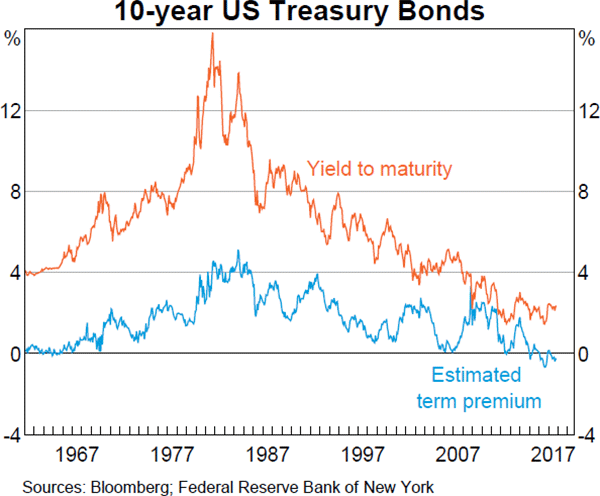
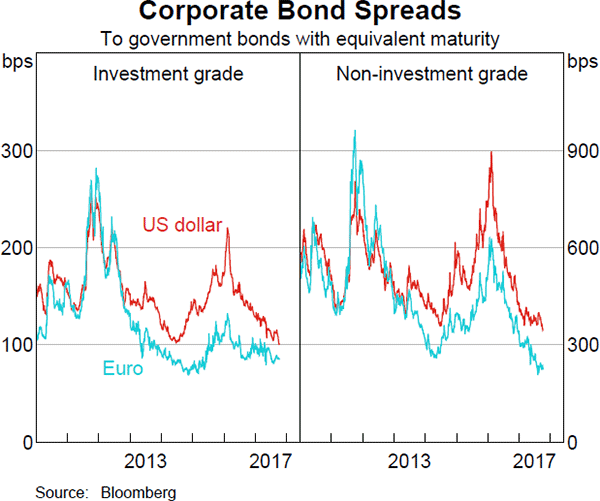
Adverse shocks are, by their nature, uncertain and mostly unexpected. A range of developments could trigger a sharp repricing of many assets. For example, long-term risk-free interest rates could rise faster than expected, without being accompanied by stronger growth, if markets were to reappraise the record low levels of term premia or the likely persistence of low inflation. Indeed, bond prices have become more sensitive to interest rates as yields have fallen and new bonds have been issued at longer tenors. Alternatively, a significant geopolitical event, such as an escalation of tensions on the Korean Peninsula, could see a sudden increase in risk premia.
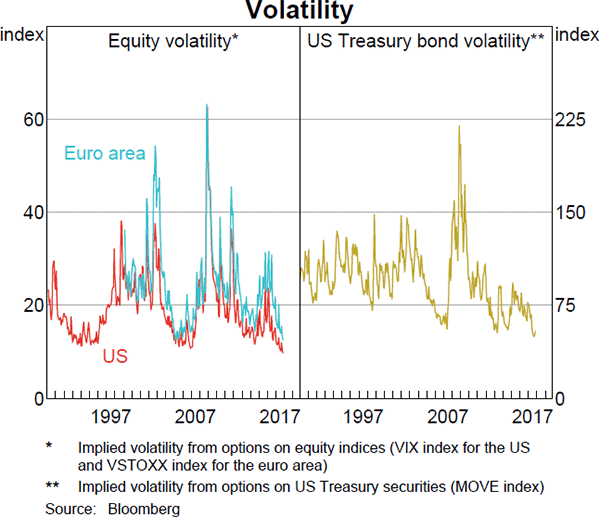
Regulatory reforms and changes in market structure have altered how bond markets are likely to respond to shocks. These regulatory reforms have been designed to transfer some liquidity risk away from financial intermediaries to end investors. This has contributed to a decline in bond market liquidity in the post-crisis period. While the reforms are likely to better allocate liquidity risk, the lower liquidity could exacerbate the price response to a sell-off in bond markets.[1]
Forced selling by bond investment funds could also aggravate a sell-off if investors in these funds redeem their holdings in response to price falls. Bond funds have become increasingly important holders of corporate bonds and often have a mismatch between the relatively low liquidity of these bonds and the easy redemption terms offered to investors. Bond funds often have tools to limit fire-sale risks, including options to suspend redemptions, although they are not available in all jurisdictions. International standard-setting bodies have also taken steps to better understand and address these risks, though reform efforts are still ongoing.
Moderate falls in asset prices or upticks in volatility are unlikely to threaten the solvency of systemic financial institutions, especially given regulatory and risk management measures taken since the crisis. However, with imperfect visibility of exposures, leverage and interconnection across the financial system, there is always the risk that some large concentrated losses could adversely affect other financial institutions. The cost and availability of funding for corporates might also be adversely affected by an increase in risk premia or disruption in credit supply, particularly for those that borrow through bond markets. This could lead to financial stress given the trends in corporate leverage noted earlier. A rapid and significant repricing of risk that coincided with other negative shocks could lead to a large increase in corporate defaults and significant losses for systemic financial institutions. Losses would be magnified if defaults fed back into a larger and more sustained rise in risk premia and greater redemptions and asset sales by bond funds.
Very low interest rates have also contributed to strong growth in property prices internationally as investors search for yield. To the extent that prices have moved beyond what their underlying determinants suggest, this increases the risk of sharp price falls if interest rates were to rise suddenly or if risk sentiment were to deteriorate. Commercial property prices have risen rapidly in recent years in parts of the United States, Canada, New Zealand and Europe. Housing credit and price growth have also been strong in many parts of the world, especially in a number of English-speaking and Nordic countries (see ‘Box A: Risks in International Housing Markets’). Prudential policies have generally led to some improvement in banking and household sector resilience, but, to the extent that authorities were also hoping to dampen growth in credit and housing prices, the effects have often been more limited or temporary.
The resilience of banking systems across most advanced economies has been improving, leading to large rises in bank equity prices over the past year (Graph 1.4). Most banks' regulatory capital ratios have increased further and are well above regulatory minimums. Profit expectations are being buoyed by improved economic conditions, with stronger loan demand and falls in bad loans. Fines resulting from legal actions and restructuring costs are also expected to be less of a drag on profits going forward. In the United States, proposals to roll back some financial regulations have become somewhat clearer and appear to focus on easing the regulatory burden for smaller banks and reducing areas where US regulations exceed international standards.
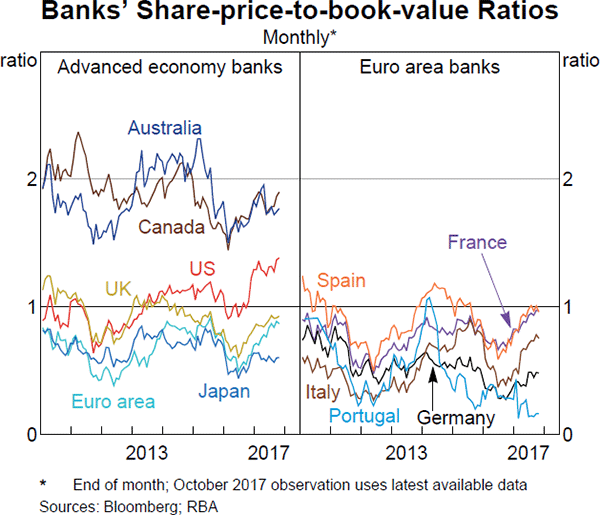
Important steps have been taken to bolster the resilience of the European banking sector, building on the effects of the ongoing economic recovery. Regulatory capital ratios and asset quality have improved following successful capital raisings and sales of non-performing loans (NPLs). Recent regulatory actions to deal with problem banks have also partly addressed long-standing sources of uncertainty in the Italian and Spanish banking systems. In Spain, the European Commission (EC) approved the resolution of Banco Popular Español, which had a large stock of non-performing real estate loans. The bank's equity and subordinated debt were written down and the bank was sold to Banco Santander for the notional sum of €1. The EC authorised a ‘precautionary recapitalisation’ of Italy's fourth largest bank, Monte dei Paschi di Siena, including the provision of €5.4 billion in state aid. The EC also approved plans to transfer the non-performing assets of two small Italian banks to the Italian Government, with the banks' other assets transferred to Intesa Sanpaolo along with a €5.2 billion capital injection from the government (plus substantial guarantees). These resolutions were a test of the new European resolution framework, which, among other things, is intended to minimise the need for governments to inject funds into weak banks. In the event, there was some flexibility in the approach, with varying degrees of public support and creditor ‘bail-in’. While this led to pragmatic solutions, it has raised some uncertainties around the circumstances in which certain types of bank debt would incur losses.
While recent developments have been positive, European banking systems nevertheless remain vulnerable to negative shocks. Bank profitability remains low in several European countries, reflecting both prolonged economic weakness and structural factors (Graph 1.5). In particular, high cost bases, legacy loss-making exposures and excess capacity are constraining profits. Low profitability makes it harder for banks to build capital buffers to absorb unexpected shocks. Stocks of NPLs have been falling but remain high (Graph 1.6). Uncertainty about the value of these loans means that banks' capital buffers could be much smaller than reported capital ratios suggest.
Sovereign debt levels remain high in some European countries, although associated near-term risks have receded somewhat over the past six months given stronger economic conditions, improved fiscal positions and pro-European Union election results. Government bond spreads to German Bunds have generally narrowed as a result (Graph 1.7). Sovereign credit ratings for Ireland and Portugal were also upgraded in September. However, negative shocks – including a reversal in global risk sentiment – could still precipitate higher government bond yields and increase concerns about debt sustainability in several European countries. The Greek Government reached an agreement with its creditors to access another tranche of bailout funding in June, and subsequently returned to the bond market for the first time in three years. However, ongoing disagreement between Greece's European creditors and the International Monetary Fund remains a barrier to more comprehensive debt restructuring.
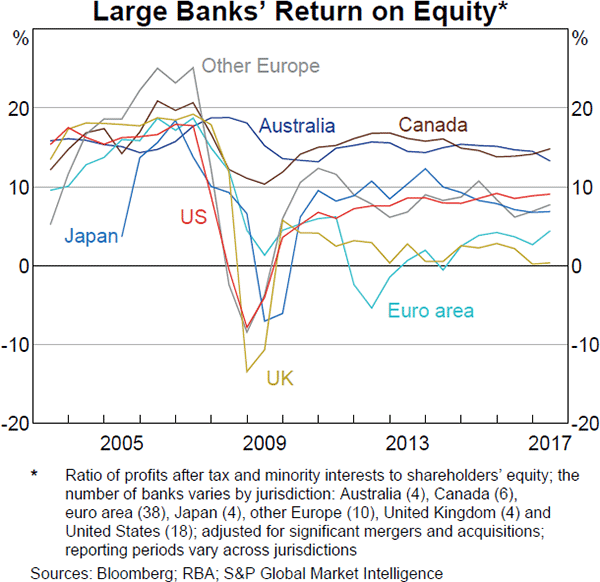
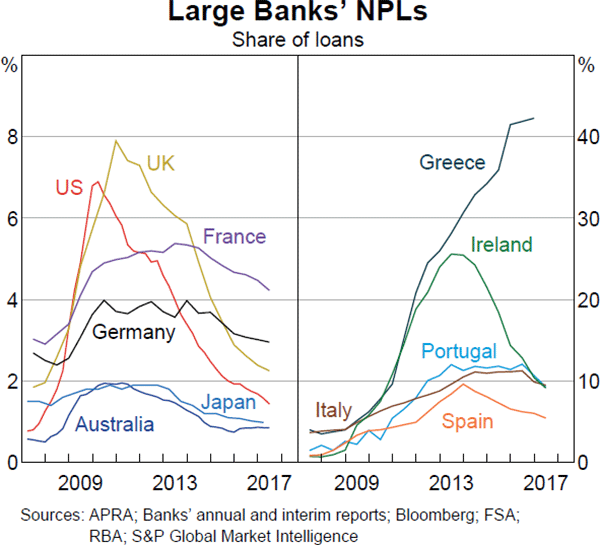
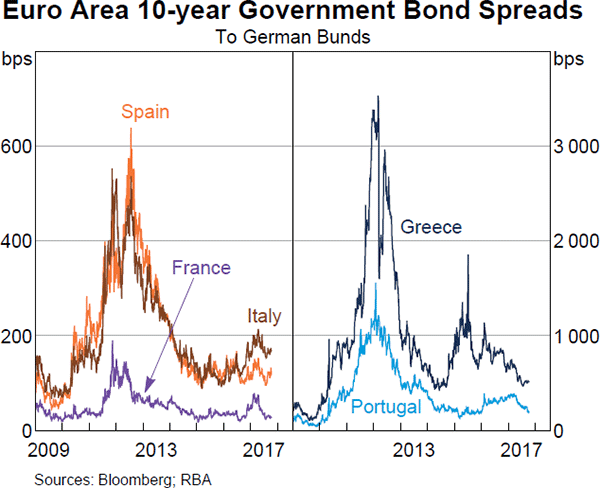
In Japan, very low interest rates continue to challenge banks' profitability, with larger banks responding by lending in offshore markets. This has exposed some banks to additional liquidity risk, due to the use of short-term foreign currency funding, and to additional credit risk. Nevertheless, large Japanese banks continue to comfortably exceed minimum capital requirements, and ongoing efforts to reduce liquidity mismatches and cross-ownership should further improve their resilience to system-wide shocks.
New Zealand
All four major Australian banks have large operations in New Zealand where, like Australia, housing-related risks have been a key focus given rapid growth in household debt and housing prices. Vulnerabilities in the New Zealand housing market appear to have lessened slightly since late 2016. Further tightening of loan-to- valuation (LVR) requirements in October 2016, a general tightening in credit standards and reduced affordability in some regions appear to have contributed to at least a temporary slowing in housing credit and price growth. These policies have also helped to limit the share of some riskier loans on banks' balance sheets; the share of high-LVR loans has continued to decline and the share of new investor lending at high debt-to-income (DTI) ratios has fallen. Despite this, the overall share of new loans with high DTI ratios remains elevated by historical standards. The Reserve Bank of New Zealand has proposed adding DTI limits to its agreed set of macroprudential policy tools, and is currently considering feedback from stakeholders.
Conditions in the dairy sector in New Zealand have improved alongside higher global dairy prices over the past year (Graph 1.8). Most farms are expected to return to profitability this year and growth in dairy-related debt has slowed. However, the sector remains highly leveraged, leaving it vulnerable to any future dairy price weakness or an increase in interest rates, raising the risk of loan losses for banks.
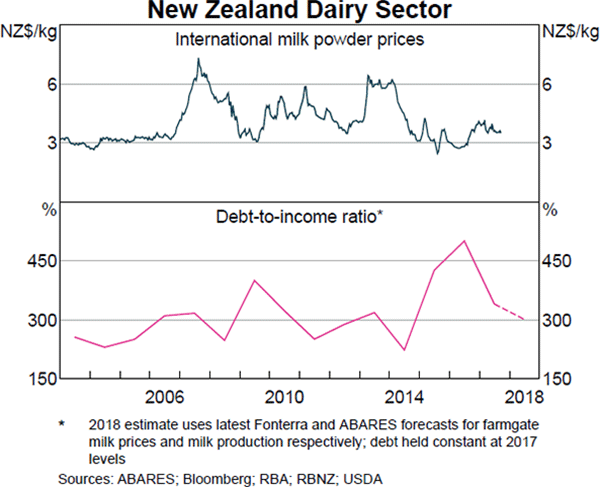
China
Chinese policymakers have recently strengthened efforts to address financial stability risks. If sustained and calibrated appropriately, these actions should help curb risks over the longer term. For now, however, financial stability risks in China remain high. Debt levels have increased significantly over the past decade, largely driven by corporate borrowing (Graph 1.9). Relative to GDP, China's corporate debt exceeds that of most advanced economies, and is more than three times higher than in economies with comparable per capita incomes (Graph 1.10). A significant part of the run-up in corporate debt has been funded through less regulated and less transparent ‘shadow banking’ channels. Lending standards in China are also likely to have been, at times, undermined by implicit government guarantees and other distorted incentives. Many financial institutions have funded the increase in lending with short-term borrowing and wholesale finance from other domestic financial institutions. Together, these developments make the system more vulnerable to adverse shocks, by raising considerable credit, liquidity and contagion risks.
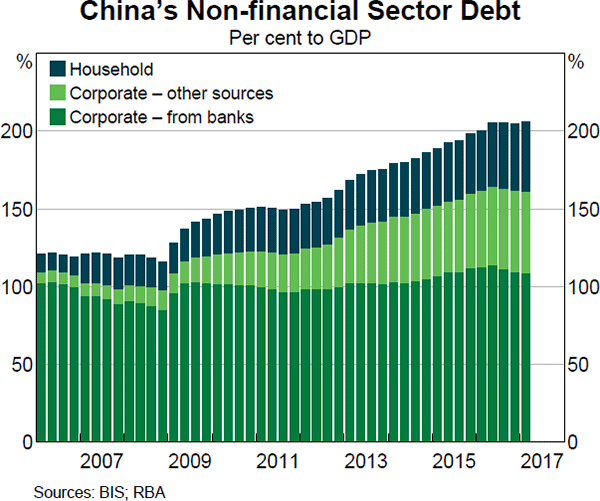
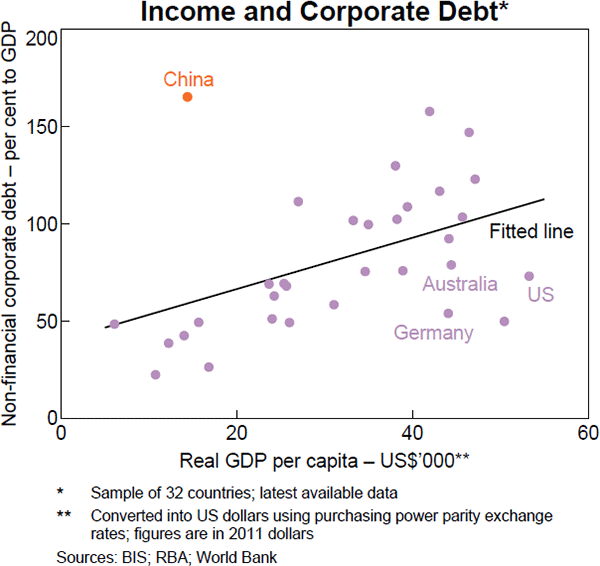
A large amount of corporate debt is owed by state-owned enterprises (SOEs) and firms in the industrial sector. Despite some recent improvement, many of these firms have low profitability, partly due to widespread excess capacity. Low profitability reduces corporates' ability to service their debts and increases their vulnerability to adverse shocks. While measured corporate distress has so far remained relatively low, supported by policy stimulus and loan forbearance, it has been rising. China's local governments have also borrowed heavily since the global financial crisis, including in recent years to fund infrastructure projects. As with SOEs, local governments enjoy favourable access to finance, in part because of implicit central government support, despite limited net revenue streams. They also have an incentive to maintain strong short-term growth. This can lead to poor investment decisions and increase the risk of repayment problems.
Non-bank financial institutions (NBFIs), or so-called ‘shadow banks’, are less regulated than banks and have rapidly expanded both their lending to firms and purchases of financial assets in recent years. Their growth has been aided by that of small and medium-sized banks, which in many cases have borrowed funds in short-term wholesale markets to invest with NBFIs (Graph 1.11). Assets of small and medium-sized banks account for around one-half of banking system assets in China.[2]
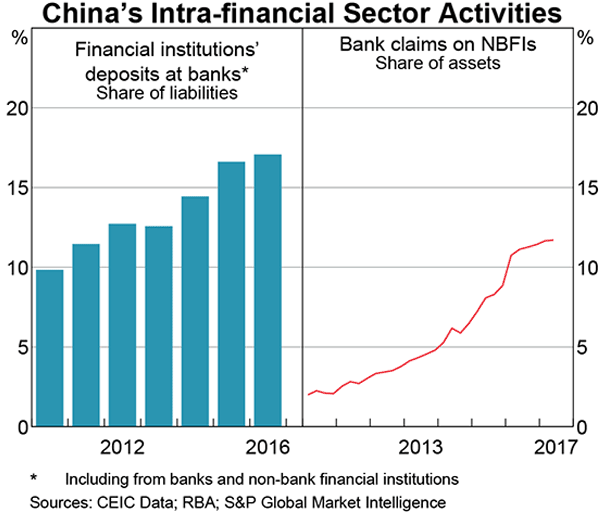
Increased lending through less regulated channels raises several risks. Such lending often involves multiple layers of intermediaries, which can obscure the ultimate borrower. This allows banks to avoid restrictions on lending to some higher-risk sectors (such as property development) thereby increasing their credit risks. At the same time, it allows banks to lower provisioning and capital requirements, which reduces financial buffers. The lack of transparency also increases contagion risk, as banks are more likely to withdraw from interbank markets when uncertainty about other banks' solvency is high. The expansion of NBFIs has raised liquidity risks, as these institutions rely mostly on short-term funding to make longer-term loans but they do not have formal access to central bank liquidity and are not backed by deposit insurance. As noted above, many smaller banks have also increased their use of short-term wholesale debt, including interbank loans. Overall, this suggests a heightened risk that loan losses and funding pressures in the shadow sector could quickly cascade through the financial system.
Risks persist in the Chinese property sector. Housing price growth has been relatively strong overall, despite slowing in many cities where measures have been introduced to cool the market. Household debt also continues to grow rapidly, although households are not highly leveraged by international standards. In contrast, property developers are typically highly leveraged, making them susceptible to large falls in the prices of properties they have financed. Developers also often obtain finance through shadow banking channels, which may be particularly unreliable during times of stress. A downturn in the property market could also transmit to local governments. Property is typically used as collateral for the debts of local governments' off-balance sheet financing vehicles, while property-related taxes and land sales are important sources of local government revenue.
Over the past year, the Chinese authorities have taken steps to address financial stability risks. Backed by strong political support, regulators have announced a range of measures to reduce leverage, improve transparency and strengthen risk management in the financial system.[3] Important measures have included restrictions on some forms of shadow lending and stricter enforcement of rules governing banks' capital, provisioning and interbank lending. The authorities have also established a Financial Stability and Development Committee to facilitate better coordination among regulators. The People's Bank of China has extended coverage of its macroprudential assessment framework to include banks' off-balance sheet activities and facilitated an increase in money market rates over the first half of the year. As a result of these measures, NBFIs' appetite for holding corporate bonds has declined and growth in some less visible forms of shadow credit has reportedly slowed. Consequently, NBFIs have reduced their holdings of financial assets, and financial conditions have tightened for corporations, although they generally remain favourable. Many smaller banks have also signalled intentions to raise equity to increase their capital buffers.
These latest regulatory measures should help to curb financial stability risks over the longer term. However, the authorities' commitment to moderate riskier financing could be tested if economic growth targets are threatened. Given the already high level of risk that has built up in the financial system, the authorities are likely to face a trade-off between strong regulatory action that could trigger financial and economic disruption and a more cautious approach that may allow a further build-up of risks. Further reform, such as facilitating the restructuring of SOEs and enhancing the fiscal discipline of local governments, will most likely be needed to address the poor governance and adverse lending incentives that have contributed to increased leverage.
China's banks remain profitable and well capitalised overall, but their profitability has been falling in recent years, in part due to higher loan losses (Graph 1.12). Despite increasing loan write-offs, reported NPL ratios have risen and would likely be much higher if measured on an equivalent basis to advanced economies. The stock of marginal performing loans (where loan repayment is at risk, but the loan is not yet classed as non-performing) has also risen strongly, possibly pointing to further increases in NPLs. Authorities in China have launched a number of programs to restructure corporate debts and help banks repair their balance sheets, such as a debt-to-equity swap program and the establishment of firm-level creditor committees comprising all relevant stakeholders to manage debt workouts. While these are having some effect on the resolution of distressed loans, NPLs will likely remain a headwind to bank profitability for some time.
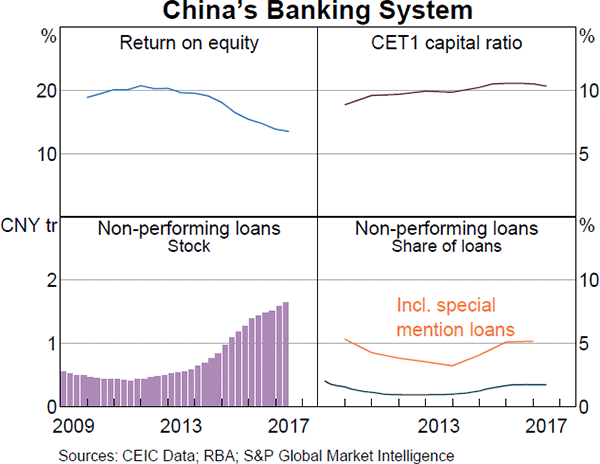
If financial risks were to materialise in China, the negative effect on China's economy could be substantial. Direct financial linkages between China and other economies are generally still small, limiting the spillovers through this channel. Rather, a disruption would most directly affect countries with strong trade links to China, including Australia, with second-round effects on a broad range of countries through weaker global growth. Weaker confidence and higher volatility in financial markets would also have global effects. As noted earlier, Chinese authorities have increased their focus on financial stability risks, and they retain a wide range of economic and financial policy tools to address them. But the more that leverage and risky lending grow, the more likely that China's economic transition will include a significant financial disruption of some form.
Other Emerging Markets
Risks in other emerging market economies have receded somewhat over the past year. Economic growth is expected to continue recovering on the back of accommodative policy settings and stronger global trade. Capital inflows have been relatively strong this year, following a temporary decline in the wake of the US presidential election (Graph 1.13). Most emerging market economies have also made progress in addressing financial vulnerabilities by increasing their banking systems' capital and liquidity ratios. Nonetheless, emerging markets remain exposed to a shift in sentiment and capital flight, which could reveal or exacerbate underlying weaknesses. One area of concern is the corporate sector, where low global interest rates have fuelled strong growth in debt in the post-crisis period, though debt has stabilised or fallen recently in many economies (Graph 1.14). Higher corporate debt levels are particularly evident in commodity-exporting economies, with the rapid pace of growth increasing the probability that some recent lending may be of low quality. A particular risk for emerging market economies is that currency depreciation would inflate unhedged foreign currency borrowing (and interest costs) at the same time that foreign lenders are less willing to roll over or extend new debt. This risk is somewhat mitigated by the large proportion of listed emerging market firms that have at least some foreign currency earnings. Rising US interest rates will also make it more difficult for emerging market firms to service their foreign currency debts.
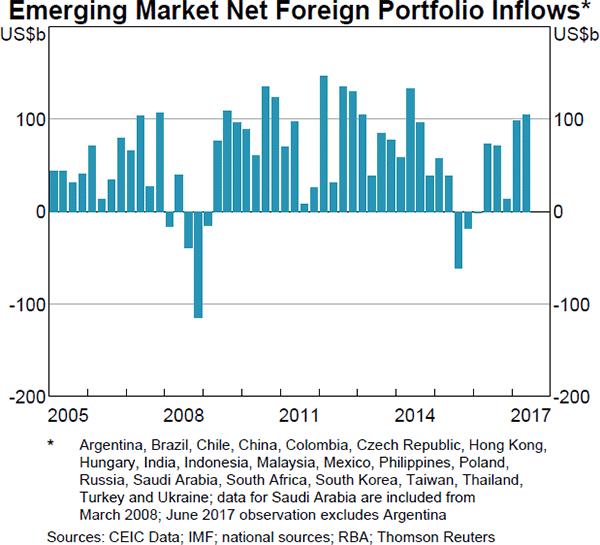
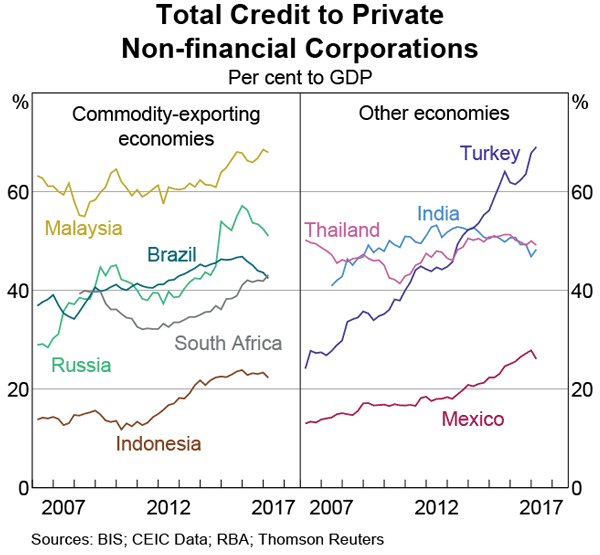
Despite challenging economic conditions in recent years, banking systems in the larger emerging market economies are generally profitable and most appear to be well capitalised.
However, bank performance varies widely within and across jurisdictions, with some banks having weak profitability and thin provisioning and capital buffers (Graph 1.15). NPL ratios have increased over recent years in some commodity-exporting economies (Graph 1.16). NPL ratios are also high and rising in India, although this partly reflects regulators' efforts to improve NPL recognition. Efforts by Indian authorities to address the risks posed by high NPLs include clamping down on loan forbearance, reviewing the asset quality of banks, and strengthening insolvency and regulatory frameworks to facilitate the resolution of distressed assets. The Indian Government has also injected capital into some weaker public sector banks and is pursuing reforms to strengthen bank governance. In Russia, the central bank recently took control of two large private lenders, as it continues efforts to strengthen and consolidate the Russian banking sector. Bank equity valuations remain low in a number of emerging economies where corporate debt has risen fastest, suggesting that investors remain concerned about underlying asset quality.
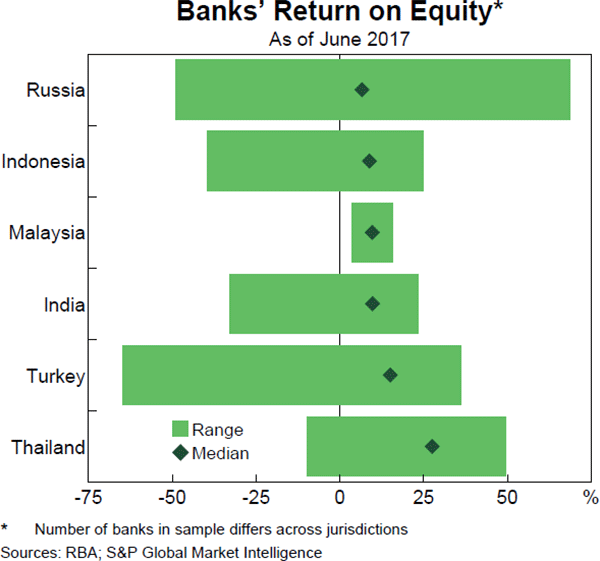
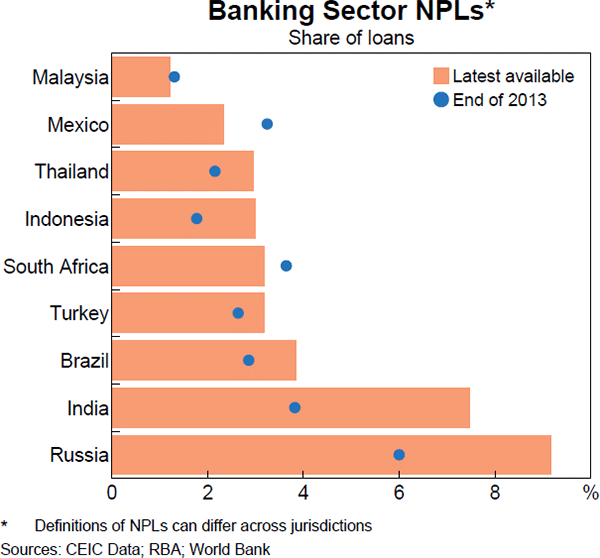
The potential for emerging market financial stress to spill over to advanced economies has risen over time due to their increased size and integration in the global economy. Advanced economies' direct financial linkages to emerging markets remain small despite some increased links, such as holdings of emerging market corporate bonds. Accordingly, any distress would be most likely transmitted through trade links and financial market sentiment.
Footnotes
For more information on developments in market liquidity in the post-crisis period, see CGFS (Committee on the Global Financial System) (2016), ‘Fixed income market liquidity’, CGFS Papers No 55, and CGFS (2014), ‘Market-making and proprietary trading: industry trends, drivers and policy implications’, CGFS Papers No 52. [1]
See RBA (2016), ‘Box A: Recent Growth of Small and Medium-sized Chinese Banks’, Financial Stability Review, October, pp 14–16. [2]
See RBA (2017), ‘Box B: Recent Developments in Chinese Financial Regulations’, Statement on Monetary Policy, August, pp 27–29. [3]